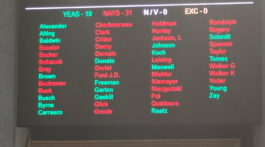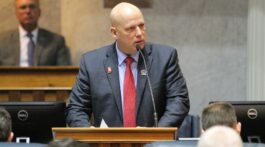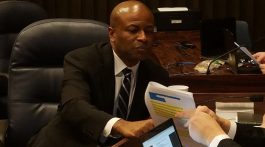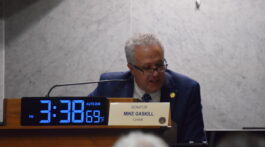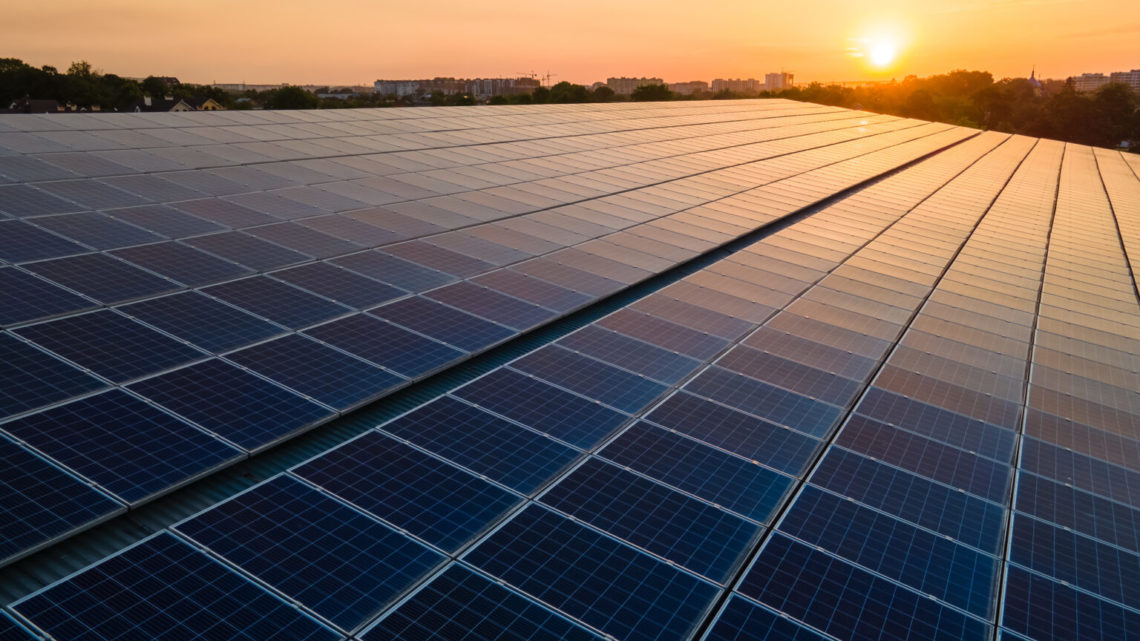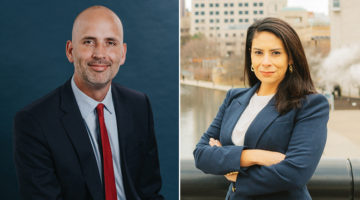by Casey Smith, Indiana Capital Chronicle
February 17, 2025
Overwhelming opposition from county officials has likely killed a Republican bill that could shift authority over large-scale utility infrastructure projects from local governments to the state.
Weeks of recent statehouse discourse around the legislation continued a larger, yearslong fight between local and state officials to decide the reach — and limits — of Indiana’s “home rule” gold standard.
And contention over House Bill 1628 seems to indicate that struggle is far from being settled.
Of greatest concern to the bill’s opponents are provisions to strip local governments of their ability to approve or deny construction of power plants, water systems, gas pipelines and transmission that span across multiple counties — instead giving the state more decision-making control over the zoning and approval processes for those proposals.
Rep. Ed Soliday, R-Valparaiso, who chairs the House utilities committee where the bill was assigned, called it a response to ongoing resistance of local governments to greenlight solar, wind and other renewables projects that are increasingly necessary to support the state’s growing energy demands.
Equally important, Soliday contended, is a transition from coal to more reliable and cost effective power sources that can sustain the influx of data centers and other economic development endeavors ventures coming to Indiana.
“We’re trying to find something, some common ground. There’s $50 billion worth of new business that wants to come to Indiana. $50 billion. They want renewable energy. Why? Not because they’re woke. It’s because they want to sell to a market that wants a reduced carbon footprint. That’s what the market is. That’s why they’re asking for it,” Soliday said. “Maybe we should just tell them, ‘Not here. We want to be an agricultural tourist state.’”
“But sooner or later, we’ve got to move past this and decide who we want to be, and where the limits of local control are,” he continued. “If we’re going to have 92 counties, 276 county commissioners, set energy policy for the state — buy some candles. Because we’re not going to be able to meet the demand.”
Critics, however, decried the proposal as “overreach,” and argued that it unfairly — maybe even “unconstitutionally” — weakens local dominion.
Representatives from the Association of Indiana Counties and the Indiana County Commissioners told lawmakers the bill would strip local elected officials of some of their most fundamental duties.
They further worried about larger implications, noting the legislation would broadly preempt locals on any energy generation projects — including carbon capture and storage, small modular reactors and battery storage, as well as water and gas pipelines — not just those involving renewables.
Also among the naysayers was Republican Lt. Gov. Micah Beckwith, who last week posted on his X account an article that framed the legislative debate as a GOP-led push to force “ugly, unreliable energy on unwilling towns.”
The Federalist piece pointed to numerous Hoosier counties — especially in northern Indiana — that have enacted moratoriums or strict zoning regulations to keep out wind and solar projects. “Common-sense counties,” it said, “are right to question the highly-subsidized renewables eating up vast acres of farmland.”
The bill was subject to more than four hours of testimony but did not receive a committee vote ahead of Monday’s deadline, seemingly killing the legislation. Soliday said “there’s no point in voting” if the bill “is going nowhere.” Even so, dead bill language can remerge elsewhere before the session ends in late April.
“Much as the states are the laboratory of the United States, counties view themselves not in a sort of cookie cutter way. What’s good in LaPorte County is good in Knox County. What’s good in Vanderburgh County is not necessarily the same thing that’s good in Randolph County,” said Jake German, representing Indiana County Commissioners. “Government closest to the people is the best form of government for those people. We are responsible and responsive to our constituents, just as (state lawmakers) are, and we work as a unit to understand the development that’s coming into the county — generation after generation after generation — and we will continue to do so and put those constituent needs first.”
Republican House Speaker Todd Huston likened the bill to a “balancing act.” He conceded, though, that lawmakers have struggled to nail down policy that would both increase the state’s energy supply and “respect personal property rights.”
“That bill is an interesting bill, but it really deals with four subject matters: personal property rights, economic development, energy policy, and local control and local government planning. And right now, I think there’s a lot of people — and I put myself in probably that camp that says one of those four gets outweighed over the other three, severely,” Huston said last week.
“We’re having this conversation about property taxes right now, and these are high economic development projects that bring in lots of property taxes, but there’s been a lot of opposition to it. … A lot of folks just feel like now’s not the right time,” Huston continued. “I do think that discussion needs to continue at the local level. And one of the things we say to people is … if you want to have the state’s investment help, you have to have pro-growth policies.”
Counties, state at odds
The proposed bill defines a “multi-jurisdictional infrastructure project” as one that involves the construction or deployment of facilities used to generate, transmit, distribute or store electricity, gas or water, and impacts residents or businesses in more than one county.
Under the original draft of the bill, such projects would be primarily regulated by the state. Local governments would no longer be able to interfere in the siting or construction of large utility infrastructure projects, even if they impact the communities they govern.
… sooner or later, we’ve got to move past this and decide who we want to be, and where the limits of local control are. If we’re going to have 92 counties, 276 county commissioners, set energy policy for the state — buy some candles. Because we’re not going to be able to meet the demand.
– Rep. Ed Soliday, R-Valparaiso
The state, rather, would oversee key elements of projects, including the location and construction of power plants with a capacity of at least 50 megawatts, as well as the deployment of infrastructure like electricity lines and gas pipelines.
A committee amendment reigned the bill in, somewhat. The latest version limits renewables from occupying more than 2% of the land in each county, unless the local governing body agrees to more. It also bars solar farms from being built on the state’s highest quality farmlands.
Supporters rallied that removing local red tape is needed to attract investment and foster quicker development, especially in rural and underserved areas.
Bill author Rep. Craig Snow, R-Warsaw, said he’s “excited” about interest from companies “wanting to come to Indiana and set up shop here.” But right now, the state lacks the energy needed for those businesses to operate.
“If and when they decide to go to another state, which has happened, Indiana and our locals lose that source of revenue. Regarding energy, what we have today is not enough to supply the demand,” Snow said in committee. “We need to fill the gap in order to remain a relevant competitor in the business sector.”
He noted that Indiana currently pays Illinois for roughly 20% of Hoosier power needs today — at a premium — because Indiana still struggles to produce cheaper, more efficient energy.
We need to create our own energy and energy sources and not rely on other states,” Snow added. “I’ll be honest, it’s a little hard for me, too. I don’t like the idea that the state was just going to control and dictate what locals do. However … we’ve got to figure out a place to get to so that we can get the energy that we need for all the businesses that want to come to Indiana.”
Additional testimony cautioned Indiana to avoid such “debacle” like in neighboring Ohio, where a law passed in 2021 allows local governments to block certain renewable projects.
The changes have empowered the state’s locals to resist multiple wind and solar projects; over the past 15 months, at least four Ohio solar projects have been abandoned due to site-permit challenges.
The siting denials have since prompted Ohio lawmakers to reverse — or at least reform — their state’s rule.
“Local concerns are absolutely important, and we certainly do our best to address them,” said Danielle McGrath, president of the Indiana Energy Association, which represents the state’s largest electric and natural gas utilities. “However, energy infrastructure that serves a broader public interest is as important, as well, given It powers our economy and heats our homes.”
Rep. Sue Errington, D-Muncie, who said she was representing herself while testifying in support of the proposal, said “controversy has paralyzed local decision makers.”
“They are unable to look beyond the angry protestors to see the benefits that renewable energy could bring to all of the citizens of our county,” she said in committee.
Bill appears dead
Indeed, dozens of county officials and concerned Hoosiers spoke out against the measure and held that renewable energy projects aren’t in “everyone’s best interest.”
Opponents connected solar and wind farms to decreased property values, and said they feared how such projects might affect the health and safety of those who live nearby.
They also worried that renewable sites will shrink Indiana’s farmland by thousands of acres, putting food production at risk.
A 2024 state inventory reported that residential development has been the primary driver for lost farmland over the last 15 years, however, while renewable energy, storage and transmission projects were not considered a significant contributor.
“Solar is so new. Will any of us be around in 30 or 40 years to hold them accountable if they don’t do their job?” he asked. “Everybody says that when it generates electricity, that’s when you’ll get paid. We’re still waiting.”
William Brown, a seven-term Carroll County commissioner, described recent forums that drew hundreds of locals in opposition to proposed windmill development.
“More than 90% of the people of Carroll County do not want wind and solar. They are very appreciative of our natural resources, of our Wabash River, of our Tippecanoe River, of the major creeks that we have, of the beauty of our county, and they do not want it blemished by these huge wind towers,” Brown said. “I’ve heard it said that we’re just old funny daddies and don’t know what’s going on. … I think that depends on where you live. … We allow lots of new things. We have lots of new industry. We’re a growing county. We’re a prosperous county.”
Soliday pushed back.
He questioned how locals can lament “shrinking” counties that are “running out of money” when they vote against “significant” income sources. It’s unfair, he said, for “91 other counties” to be on the hook for funding shortfalls in those that “turn down revenue.”
“This is a tough year on the budget. … We went through a period where a lot of federal money came in, and it’s not here anymore. So, finding ways to increase revenue for the counties is something that needs to be in the thought process,” Soliday said.
“Nobody gets everything they want when they come to the statehouse,” he continued. “And government works when there’s give and take on both sides, and when you try to define what the problem is you’re trying to solve — and try to find solutions to that problem that either make everybody equally unhappy or sort of happy.”






